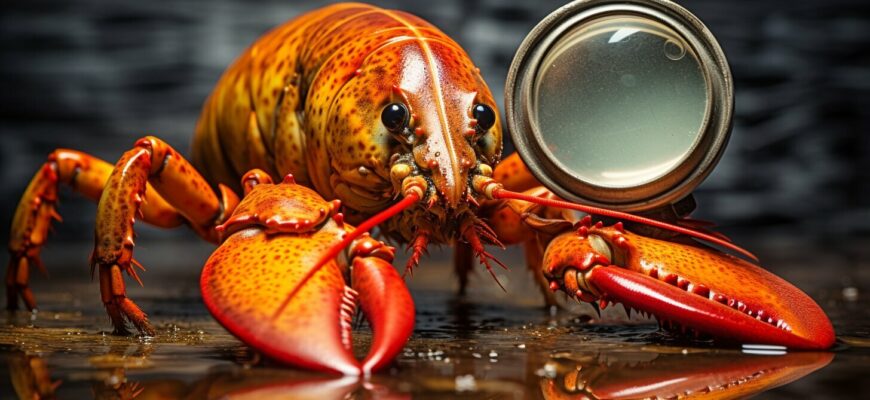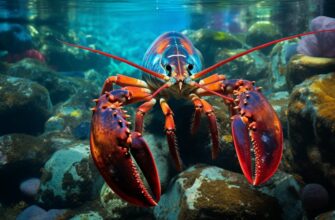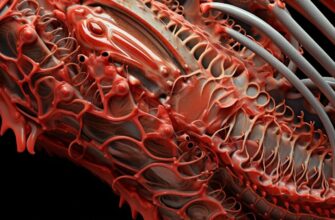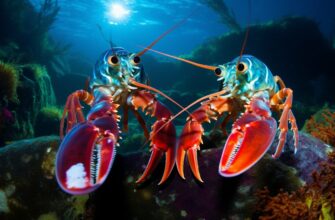Have you ever wondered if lobsters are truly bugs? Despite their striking resemblance to giant insects, lobsters are not classified as bugs. In this section, we will explore their characteristics and anatomy to shed light on this fascinating topic.
Firstly, let’s take a closer look at the physical traits of lobsters. They have a hard exoskeleton, jointed legs, and two pairs of antennae, which are all characteristics shared with insects. However, their anatomy also includes complex internal organs, such as a digestive system and a nervous system, that set them apart from bugs.
- Understanding Lobsters in the Animal Kingdom
- Classification of Lobsters
- Lobster Species
- Differences Between Lobsters and Bugs
- The Fascinating World of Lobster Anatomy
- Different Types of Lobsters
- Lobsters: Bugs or Not?
- Unveiling Fascinating Lobster Facts
- Frequently Asked Questions about Lobsters
- How long do lobsters live?
- How do lobsters mate?
- Can lobsters regrow their claws?
- Are all lobsters red when cooked?
- How are lobsters caught?
- Are lobsters really bottom feeders?
Understanding Lobsters in the Animal Kingdom
Lobsters are a type of marine crustacean that belong to the family Nephropidae. Although they may seem similar to insects, they are actually not classified as bugs. In fact, lobsters and insects are quite different in a number of ways.
Unlike insects, lobsters have complex body structures that include an exoskeleton, multiple pairs of jointed legs, and antennae. They also have a more diverse range of body shapes and sizes, with some species growing up to 4 feet long!
Classification of Lobsters
Within the animal kingdom, lobsters are classified as arthropods, which means they have jointed limbs and an exoskeleton. However, they belong to a different class than insects – the class Malacostraca – which also includes crabs, shrimp, and crayfish.
Despite their classification as arthropods, lobsters share more similarities with other crustaceans. For example, they have two pairs of antennae, and their eyes are located on stalks. Additionally, lobsters have five pairs of legs, with the first pair modified into large claws that they use for defense and catching prey.
Lobster Species
There are over 50 species of lobsters that exist across the globe, with several types being commercially harvested for food. The American lobster (Homarus americanus) is one of the most well-known species, and is commonly found in the Atlantic Ocean along the eastern coast of North America. Other species include the European lobster (Homarus gammarus) and the spiny lobster (Panulirus spp.), which is found in warmer waters around the world.
Differences Between Lobsters and Bugs
While lobsters share some similarities with insects, there are several key differences between the two groups. Firstly, insects have three distinct body segments – the head, thorax, and abdomen – while lobsters have two – the cephalothorax and the abdomen. Additionally, insects have wings, while lobsters do not.
Another major difference is in their digestive systems. Insects have a specialized system for digesting their food, while lobsters have a more generalized digestive system that can break down a wider range of foods.
Overall, lobsters are a unique and fascinating group of animals that are worthy of further study and appreciation.
The Fascinating World of Lobster Anatomy
Lobsters are intriguing creatures with unique anatomical features that allow them to thrive in their marine habitat. Let’s explore some of the most distinctive aspects of their anatomy:
| Exoskeleton | Lobsters have a hard, protective exoskeleton made of chitin that covers their entire body. This exoskeleton not only provides structural support but also serves as a defense mechanism against predators. |
|---|---|
| Appendages | Lobsters have five pairs of appendages, each with a specific purpose. The first pair is the claws, which are used for defense, feeding, and communication. The second pair is the walking legs, which help lobsters move along the ocean floor. The remaining pairs are used for swimming, grooming, and sensing their surroundings. |
| Digestive System | Lobsters have a digestive system that starts at the mouth and ends at the anus. They have two stomachs, one for grinding and one for digesting food. They also have a long, coiled intestine that absorbs nutrients from their food. |
| Reproductive System | Lobsters have separate sexes and reproduce through internal fertilization. Males transfer sperm through a pair of specialized swimmerets located near their tails, which females then use to fertilize their eggs. Females carry the fertilized eggs under their tails until they hatch into larvae. |
Overall, lobster anatomy is a fascinating subject that offers insight into the incredible adaptability and survival strategies of these creatures.
Different Types of Lobsters
When it comes to different types of lobsters, there is more to discover than just the famous Maine lobster. Here are three types of lobsters that you might not have heard of:
| Lobster Type | Distinctive Characteristics | Habitat |
|---|---|---|
| Spiny Lobster | Long spiny antennae, no claws, brownish-red body color | Warm waters of the Caribbean, Gulf of Mexico, and Florida Keys |
| Rock Lobster | Similar to spiny lobster, but with a harder exoskeleton and bigger claws | Found in rocky, shallow waters off the coast of Australia and New Zealand |
| Ornate Spiny Lobster | Also known as the “dragon lobster” due to its distinctive spiny appearance | Found off the coast of Australia and Indonesia, in warm, shallow waters |
Each of these lobsters has their own unique characteristics and habitats, highlighting the diversity within the lobster family. Whether you prefer the meaty claws of the rock lobster or the spiny antennae of the spiny lobster, there is a type of lobster for everyone.
Lobsters: Bugs or Not?
For years, the classification of lobsters as bugs has stirred confusion among scientists and the general public. So, are lobsters truly bugs? Let’s investigate.
While lobsters share some characteristics with insects, such as an exoskeleton and segmented body, they belong to a different phylum. In fact, lobsters are more closely related to spiders and scorpions than to insects.
One of the most distinctive features of lobsters is their unique anatomy. Their large claws, antennae, and fan-like tail distinguish them from any insect species. Plus, unlike bugs, lobsters have a well-developed nervous system and can sense pain.
So, in conclusion, lobsters are not bugs. While they share some similarities with insects, their anatomy, habitat, and classification place them in a different category.
Unveiling Fascinating Lobster Facts
Think you know everything there is to know about lobsters? Think again! These fascinating creatures have many hidden secrets that may surprise you. Here are some fun facts about lobsters:
- Lobsters can regenerate lost limbs. That’s right, if a lobster loses a claw or leg, it can grow a new one. It may take a few molts, but eventually the new limb will be fully functional.
- Lobsters have been around for a long time. Fossil records show that lobsters have been around for at least 100 million years, making them one of the oldest species on the planet.
- Lobsters can live for a very long time. The average lifespan of a lobster is around 50 years, but some have been known to live for over 100 years!
- Lobsters can travel great distances. Lobsters are known for their long-distance migrations. Some have been tracked traveling over 100 miles in a single year.
- Lobsters are nocturnal creatures. Lobsters are most active at night, when they scavenge for food and socialize with other lobsters.
- Lobsters are romantic creatures. When a male lobster is interested in a female, he will first start by courting her with a dance. If she’s interested, she’ll respond with her own dance, and the two will mate.
“Lobsters are known for their long-distance migrations. Some have been tracked traveling over 100 miles in a single year.”
These are just a few of the many fascinating facts about lobsters. Who knew these crustaceans had so much going on beneath their hard shells?
Frequently Asked Questions about Lobsters
Curious about these fascinating creatures? Here are some of the most commonly asked questions about lobsters:
How long do lobsters live?
Lobsters have a surprisingly long lifespan, with some species living up to 100 years in the wild! The average lifespan of a lobster is around 50 years, which is longer than most other commercially harvested species.
How do lobsters mate?
Lobsters mate through a process called ‘mating embrace’, where the male lobster grasps onto the female’s carapace with his claws and deposits a packet of sperm into her reproductive tract. Females can store the sperm for several months before fertilizing her eggs.
Can lobsters regrow their claws?
Yes, lobsters have the ability to regenerate lost claws and limbs. This process can take several molts, which can be a vulnerable time for the lobster as it has to protect itself from predators without its usual defenses.
Are all lobsters red when cooked?
No, not all lobsters turn red when cooked. In fact, some species of lobsters have a natural blue or green coloration due to the presence of pigments in their shell. These colorful lobsters are often highly prized by seafood lovers.
How are lobsters caught?
Lobsters are typically caught using traps or pots, which are baited with fish or other seafood. The traps are lowered to the ocean floor and left for several hours before being retrieved. This method of harvesting is considered to be sustainable as it allows for selective harvesting of mature lobsters while releasing smaller or undersized ones.
Are lobsters really bottom feeders?
While lobsters are often associated with scavenging on the ocean floor, they are actually opportunistic feeders that will eat a variety of prey including fish, crabs, and other crustaceans. They are also capable of catching live prey using their sharp claws and swift movements.
Now that you’ve learned some interesting facts about lobsters, it’s time to enjoy them in all their delicious glory!









